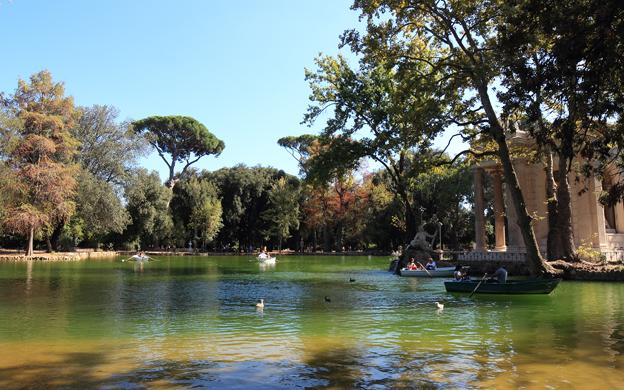[Photo: Villa Borghese.]
See a different side to Rome, escape the bustle and crowds, wander in peace and nature: on your next visit to the Eternal City, make some time to discover some of its most beautiful gardens (and there's history in them too).
Villa Borghese
The third largest public park in Rome, Villa Borghese, perhaps most famous for being the site of the Borghese Gallery, is a delightful green oasis right in the center of Rome. It can be reached from the top of Via Veneto or by walking up the Spanish Steps to the Pincian Hill which, incidentally, offers a fantastic view of Rome. But back to the gardens, 17 acres of them still stand on the site of the ancient Gardens of Lucullus, laid out around 60 BC by Lucius Lucullus, a politician of the late Roman Republic, for his Patrician villa; his gardens are considered one of the first attempts to tame nature through landscape gardening.
The gardens were developed for the Villa Borghese Pinciana by the architect Flaminio Ponzio, developing sketches by cardinal and art collector Scipione Borghese, who used it as a villa suburbana, a party villa at the edge of Rome (it now houses the Borghese Gallery).
The current gardens were remade in the early 19th century in the English taste and feature lovely paths lined with statues, fountains, several villas and museums, an artificial lake with a 19th-century Greek-style temple, and even a zoo.
A great way to explore the 80-hectare Villa Borghese gardens is by renting a bike.
Villa Doria Pamphili

If you were wondering which is the largest public park in Rome, Villa Pamphili, at 184 hectares, is it. Laid out in the 17th century, it is located on the Janiculum Hill, just outside Porta San Pancrazio, and is the Romans’ favorite place to escape the city’s bustle or to engage in leisure and sports activities.
As many other city parks, this one too originates from a suburban villa built for a wealthy Roman family, in this case that of Prince Camillo Pamphilj, nephew of Pope Innocent X, around 1650.
Shaded by Rome’s classic umbrella pines, it features manicured gardens and citrus trees. At the center is the Casino del Bel Respiro, once the prince’s summer residence, now used for government functions. Adjacent to it on the south side is the Giardino Segreto (Secret Garden), designed according to Giardino all’italiana, Italian-style garden. Other gardens grace the grounds of the villa, including the Giardino dei Cedrati, so called for the number of citrus trees planted there. There was even a hunting reserve, today the Valle dei Daini.
A bike path runs through the park.
Orange Garden (Giardino degli Aranci)

What this small park on the Aventine Hill lacks in size more than makes up in views – in fact, its popularity is mainly due to the breathtaking vista over Rome, which stretches from the Tiber river to St.Peter’s Basilica.
Giardino degli Aranci was built over the ruins of the Savelli family fortress, built in the 14th century. The name derives from the many orange trees growing in the park. These were planted in homage to Saint Dominic, who founded a monastery here and, according to legend, gave the park its first orange tree.
The rectangular garden is symmetrical in its layout, with a central avenue aligned with the viewpoint. The fountain at the entrance is adorned with a marble mask made in the 16th century.
Come for a picnic at sunset while enjoying the views.
Villa Celimontana

The gardens of Villa Celimontana are located on the top of the Celian Hill, a tranquil green space covering most of the valley between the Celian and Aventine hills, between the Colosseum and the Baths of Caracalla, of which the park is a continuation. This is where you come if you want to escape the crowds of tourists while reveling in beautiful gardens.
The gardens were famous for their fountains made by Bernini, which included the Fontana dell'Aquila and Fontana del Tritone, now relocated to nearby Piazza SS.Giovanni e Paolo. The original villa and first garden were built on the site of a vineyard in the 16th century. The villa now houses the Italian Geographic Society, where some of the most important maps of Italy are kept.
Rose Garden

This may very well be the most romantic park in Rome, not only for its quiet and beautiful grounds, but especially for the 1,100 rose varieties that blossom in the spring. Located on the Aventine Hill opposite the Circus Maximus, it offers exceptional views over the ancient chariot racing stadium and the crumbling palaces of the Palatine Hill.
But aside from the views, the roses are the star attraction, covering 10,000 square meters divided into sections according to groups and garden potentials: hybrid roses, miniature roses, rose shrubs, modern climbers, etc., as well as roses climbing up pergolas and pillars, rambling roses, roses with decorative fruit, hedges made up of rose bushes, and more. According to Tacitus, a temple dedicated to Flora adorned with flowers was on the site since the 3rd century BC.
The park is only open in the spring time when the roses blossom, roughly from mid-April to mid/late June.











